PART II
The U.S. Navy
Chapter
3
SEAMAN
Upon enlisting in the Navy,
Gover and Aunt Mary presented Gordon with a gold ring with GGB
engraved on the front. Inside it had the inscription “1941”. They
also gave him a Swiss watch that was also engraved with “1941”. 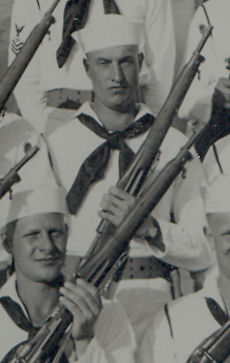
Gordon in boot camp. Cropped
from the picture of his
company, below.
A few days later, he rode the train to San Diego for Basic Training. On the train he met a girl from Smithfield, Utah who was on her way home to Los Angeles. She knew a lot of his cousins and people he knew. Smithfield is just a few miles from Clarkston. She told him if he ever got in Los Angeles to look her up and gave him her address. He never did anything about it.
Boot camp was an ordeal that he hated going through. He had it in his mind to join the Navy and ride a ship so he wouldn't have to walk. In boot camp they marched everywhere. In October, Gordon got word that Milton's wife, Annabel, had died in childbirth. He asked the chief if it would be possible for him to take leave and go to her funeral. The Chief told him that it was possible but if he did, he would have to finish up in a company that was behind him. He didn't recommend it, so Gordon stayed. One day long about October the company was goofing up and not doing things right. The Chief pulled them over into the shade and gave them a talk. He told them, "You think you're in here just to have fun! Well, you're all going out in the Pacific and fight Japs." Boot Camp lasted six weeks and was not worth remembering.
After Boot Camp, he came home
on a leave for nine days before going back to San Diego. His company
was assigned to report aboard the three aircraft carriers in the
Pacific Fleet. The three carriers were the Lexington, Saratoga, and
the Enterprise. There were sixty men, twenty for each ship. They each
got to sign up for the ship they wanted. Gordon and his buddy,
Martinez, sat on the running board of a car until everyone else was
done and took what was left. They wanted to be on the same ship and
didn't realize that one could end up on one ship and the other on
another. When they went to sign up, there were two places left for
the U.S.S. Enterprise.

From North Island, he departed for Pearl Harbor in the Hawaiian Islands where he was to go aboard the Enterprise. When he wrote home to tell his family, he did not even know how to spell Enterprise, (he spelled with an I) let alone know what an aircraft carrier was. It took nine days to go from San Diego to Pearl Harbor aboard an old troop ship, the U.S.S. Henderson. He got there on December 4th. In three days, his life and the whole world would never be the same again.
In Pearl Harbor, so many miles from home out in a big ocean, Gordon ran into somebody from Burley, Louis Jones. He was stationed aboard the U.S.S. Oglala. They decided they would get together on Sunday when Louie was off duty and the two of them would spend the day together. Until the Enterprise returned from sea, Gordon stayed at the Receiving Ship, a barracks for people in transit.
Sunday he had plans of seeing Honolulu and the rest of the island first hand. He left the Receiving Ship early enough to get a good start. As he left, Gordon paused a moment to salute the flag as he went by. The time was 7:55 am, Sunday December 7, 1941. The sky was filled with aircraft from the airfields around the island ... NO! ... They were Jap dive bombers and torpedo planes. In an instant, Pearl Harbor became a mass of confusion, and explosions, and fire, and smoke, and destruction.
Not knowing what else to do,
Gordon ran down to 1010 dock where he was to meet Louie. He got there
just as the Oglala rolled over. He found Louie on the dock with a 30
caliber machine gun mounted on a tripod next to a little building.
Louie immediately put Gordon to work loading the machine gun as he
fired at the unannounced enemy.
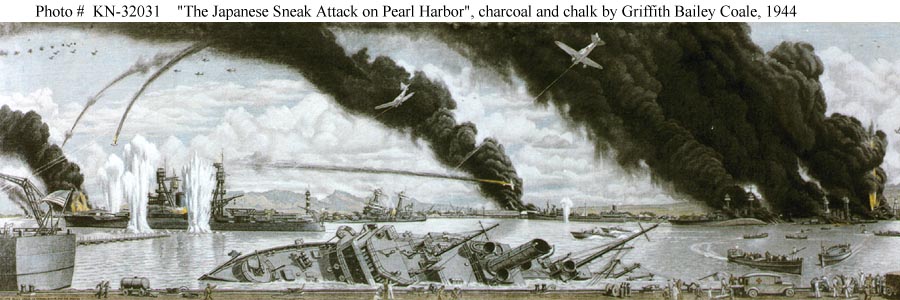
This is a paining of the attack on Pearl Harbor as seen from 1010 Dock. In the foreground is the Ogala rolling over. Battleship row is shown in the background.
Eventually, someone came and got Louie because they needed him elsewhere. Gordon was left alone to load and fire the gun himself. There was a Zero (Jap fighter plane) circling overhead nearby. Gordon opened fire on it but about all he did was to annoy the enemy pilot. What a target, an unexperienced farm boy behind a 30 caliber machine gun, and down he came strafing all the way. When he was close enough to see the pilot's face, Gordon decided it was time to leave. Down the dock he ran with bullets ripping the concrete at his heels. The plane passed overhead and into the sky already crowded with planes and smoke.
With the Zero off his back, he kept running down the dock passed a square sterned cruiser, the USS Helena. A pickup full of marines picked him up. Where they were going didn't matter, there was no place to go. Another Zero dived out of the sky strafing the pickup. Gordon and the marines all scrambled at once to the bottom of the pickup for cover. Somewhere along the way, they let him off and he ended up out in the harbor on a tug boat fighting fires on the Battleships.
At one point, he saw someone climbing a ladder up one of the huge oil storage takes. A nearby Marine raised his rifle and shot the man. Saboteurs had been a major concern prior to the attack. Whatever the reason he was climbing the tank, the Marine wasn't taking any chances.
From Sunday morning until Monday night became one day without any recollection of what he had done. He found himself in a chow line back at the Receiving Ship when someone from his group spotted him. The Enterprise came in Monday night after dark. He just had time to get his gear and go aboard. He was still wearing his white uniform and was a real mess from the smoke and sweat. At this point, Gordon's story and the story of the Big E become in the same.
He went aboard about ten o'clock that night. Gordon remembers walking up the gangway with his sea bag over his shoulder. Once aboard they put the twenty new "boots" in a safe place out of the way on the hanger deck while the ship took on fuel and provisions. The next morning while it was still dark, the Enterprise began to get under way. Gordon could feel the ship moving and walked over to the edge of the ship to watch what was going on. He could see the little tugboats pulling the ship away from the dock. Gordon thought to himself, "Oh my God. It must be helpless if it has to be pulled around by little boats."
As it got lighter, he looked
around and got a worse impression. The size was more than he could
imagine. The Enterprise was 824 feet long and 114 feet wide and
weighed 20,000 tons. When he looked around and saw all that iron, he
knew he was in trouble. Back home, if you through a piece of iron in
the ditch, it would sink!

The USS Enterprise - late 1941
Meanwhile back in Burley, his folks heard the announcement of the attack on Pearl Harbor. Knowing their son was there, they anxiously awaited word from him telling them he was alright. Instead, they got a telegram from the Department of Naval Personnel stating that Gordon was missing in action. The loss of Ervin was still fresh in their memories, now the fate of Gordon was uncertain. Since he hadn't mustered in when he returned to the Receiving Ship before reporting aboard the Enterprise, no one knew where he was.
He had breakfast Sunday morning before the attack, and didn't eat again until Tuesday morning at sea. By then he wasn't even hungry. Upon reporting aboard he was assigned to the deck division. In charge was a Chief Boatswain's Mate by the name of Holdebe. Before his records caught up with him, he wasn't getting paid, and didn't have any money for a while. After a couple days at sea, Holdebe asked him, "Why don't you clean up'?" Gordon's reply was, "I don't have anything to clean up with." "Aren't you getting paid?" he was asked. "No," he answered. "I guess my records aren't aboard yet." So, Holdebe gave him some money until he got paid.
Gordon was assigned a bunk in the crew quarters below decks. Having witnessed first hand what a torpedo can do to a ship, he didn't want to be down there on the waterline and have one hit the ship. He wanted to be where he could get off. So he found an army cot and some lockers up on the hanger deck level (or the main deck) near his battle station and that was where he bunked.
It wasn't long before he found out how "all that iron" could maneuver. During the week that followed Pearl Harbor, the Enterprise patrolled the waters around Oahu for enemy submarines. There were plenty of sightings, and dive bombers from Enterprise sunk one on the 10th. The first Japanese ship to be sunk during the war.
There were plenty of false
submarine sightings as well. Gordon's battle station was on the five
inch antiaircraft guns. One of these false sightings was a whale that
surfaced right close to the ship and to some scared sailors it looked
like a submarine surfacing. They opened fire with the five inch guns,
getting a direct hit on the unsuspecting whale. A destroyer could see
what was going on and began signaling to call attention to the fact
that it was only a whale. The Ensign over the gun crew was going to
put them on report for opening fire without orders. When Admiral
Halsey heard about it, he dismissed the charge by stating, "We'll
shoot first and ask questions and figure out what we did later."
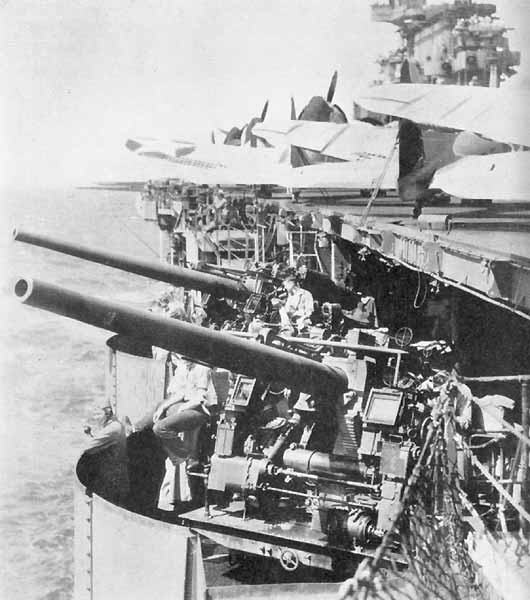
The aft port 5" gun mount February 1942
On the five inch guns Gordon learned how to preform all the duties pertaining to their operation. It took a crew of several men for each gun. The five inchers were arranged around the ship in groups of two. They were located fore and aft on both sides. The ship had eight of these big antiaircraft guns along with sixteen 1.1 inch antiaircraft guns in four mounts, two forward and two aft of the island structure. There were also twenty-four 50 caliber machine guns that were arranged in batteries along both sides of the flight deck.
To operate the five inch guns, It took a man to turn the cranks that elevated and rotated the barrel. One to load the powder shell, one to set the fuse on the projectile, another to load it into the gun. Then the gun captain "rammed it home" and fired the gun. A man with big asbestos gloves caught the empty powder can as it was ejected from the barrel after it was fired. There was also a man who was in communication with sky control in the island structure, who told the gun crew where to aim and fire. The five inchers had a range of thirteen miles.
The main battery on an
aircraft carrier was its air group. The Enterprise carried between
eighty and ninety planes. There was a fighter squadron consisting of
two or three dozen fighters. They were the first line of defense in
defending the ship and the task force against enemy air attack. There
were always several in the air on combat air patrol. They also
accompanied the the bombers and torpedo planes on missions. 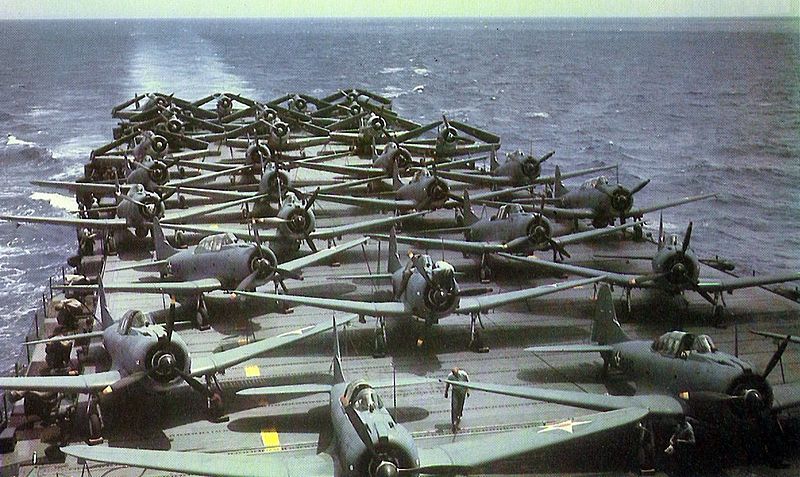
The flight deck full of planes (Dive bombers in the fore-
ground and torpedo planes with their wings folded in the
background.) - About December 1941
The Enterprise carried two squadrons of dive bombers, one was designated as a scouting squadron. These plane carried either a five hundred our a one thousand pound bomb under their belly. Behind the pilot sat the rear seat gunner with a thirty caliber machine gun. The remaining squadron consisted of between fifteen and eighteen torpedo bombers. They were capable of carrying either a torpedo or two bombs.
With the war in the forefront of everyone's consciousness, everyone was uncertain of their futures and the prospects of facing battle. The twenty new boots had something the seasoned veterans did not have, battle experience. They were often asked what it was like to be in battle. In the months to come, they would all find out.
The Enterprise returned to Pearl Harbor on the 17th. At that time Gordon's records caught up with him. Even though his records were brought aboard, it was about six weeks from the time he went aboard until he got paid. Gordon received twenty-one dollars a month for his wages. His family then got another telegram from the Navy, this one stating that Gordon was alive and well.
The ship was only in Pearl Harbor for a couple of days before heading back to sea to patrol the area west of Oahu and provide support to the failed attempt to relieve the Marines on Wake Island. By the the time they returned to Pearl Harbor on the last day of the year, Gordon pretty much had his sea legs under him. Now that the Navy was operating under war conditions, the carriers didn't stay in port very long. Of the three carriers, only one was in port at a time in case the Japs returned for another attack. The Enterprise and her escorts departed again on the 3rd of January so the Lexington could come in. The Big E spent the next four days conducting training exercises north of Oahu.
While in port, the crew
was granted shore leave. During these times Gordon finally got to
look around Honolulu and parts of the island. Waikiki Beach had lost
it's peacetime appeal as it had barbed wire was strung along the
otherwise beautiful sandy beach. The sun bathers had been joined by
soldiers on patrol.
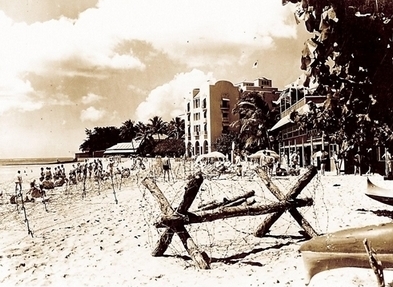
The Royal Hawaiian Hotel and Waikiki Beach
behind barbed wire
After another brief stay, the Enterprise put to sea on the 11th of January, surrounded by the screening vessels, and set course for the South Pacific to provide cover for the reinforcement of Samoa. That same day, the US carrier force was reduced by one as the Saratoga had been torpedoed off Oahu. She would be out of commission for the next six months while being repaired on the west coast.
Four days after leaving Pearl Harbor, the Enterprise and her task force crossed the equator. Traditionally when a ship crossed the equator, an elaborate celebration was held by the shell backs to initiate the polliwogs who had not yet crossed the line. Because the task force was on heightened alert, the ceremonies were canceled. On the 18th Gordon was promoted to Seaman 2nd Class. A few days later, the Enterprise rendezvoused with another task force centered around the Yorktown, which had just came from the Atlantic. Together they patrolled the area around Samoa as the Marines went ashore.
With Samoa secured, the Enterprise and Yorktown were ordered to carry out the first strikes against the enemy in the Marshall and Gilbert Islands. As they sailed northwest, they recrossed the equator as well as the International Date Line. The two groups separated and took up their positions.
On February 1, 1942 the Enterprise air group attacked the Japanese held islands of Wotje, Roi, and Kwajalein in the Marshall Islands. The strategy was to go in and attack and retreat and attack another island and retreat again, thus keeping the Japs guessing as to the American's strength and position. During the raid the Enterprise was in range of attack by Jap land based bombers. Later in the day a formation of Betty's (twin engine bombers) attacked the Enterprise and her escorts.
Gordon was the first shellman on the gun crew, the one who loads the shell. The process was for the first shellman to touch the first powderman once the shell was loaded. He would in turn touch the gun captain and he would then fire the gun. Evidently, someone must have bumped the gun captain. The gun captain began to "ram it home" before Gordon had his arm out of the way. When Gordon felt the powder rammer bump his arm, he hurried and jerked it out of the way before his arm ended up in the barrel or even worse, out the other end. He could have been seriously hurt.
Gordon filled about every position in the gun crew. They were rotated around so everyone knew everything about the gun mount. During one of these early engagements, the Ensign who was the gun captain got scared and panicked. An experienced 2nd Class Bosun's Mate took his head phones and told him to sit in the corner out of the way. As the firing continued he told the Ensign to get up and help pass ammunition. Later the Ensign thanked his much wiser subordinate.
Of the fifteen bombs dropped
by the formation of Bettys, all missed the ship, but one went off in
the the water only thirty feet away which stated a small fire and
caused minor damage. The last bomber in the formation had been hit
and fell out of formation in an attempt to crash dive into the
Enterprise. All guns in the task force focused on the plane as it
kept coming. The Captain ordered a sharp turn to avoid being hit but
the desperate pilot maneuvered to keep the fast moving ship before
him. At the last minute, one wing of the bomber sliced through a dive
bomber parked on the flight deck as it continued on its way and
crashed into the sea. Seconds later it sank as the ship passed the
wreckage. With her mission completed, the Enterprise returned to
Pearl Harbor on February 6th. 
A Mitsubishi G-4M Betty twinned
engined bomber
After a week in port, the Enterprise set out once more on the 14th with orders to attack the enemy on Wake Island on the 24th. With that accomplished, Admiral Halsey received orders to take his ships deep into Jap waters to attack Marcus just a thousand miles east of Tokyo on the 4th of March. The raids on Wake and Marcus were carried out without counter attacks form the enemy. All the while, the ships were at full alert and Gordon was at his battle station almost continually. With the mission accomplished, they returned to Pearl Harbor on 10th.
On this stop over at Pearl
Harbor, Charles A. "Tommy" Tomilson came aboard and was
also assigned to the deck division. He and Gordon became close
friends. While in port, the ship took on provisions for its next
mission. At this time, the Enterprise got a fresh coat of dark sea
blue paint. Being part of the deck division, Gordon no doubt got in
on the paint job. The 50 caliber machine guns were replaced by thirty
six of the more capable 20 millimeter anti-aircraft guns.
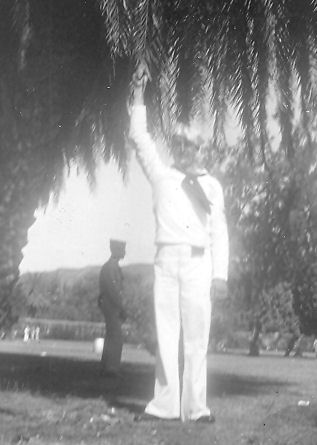
Gordon on shore leave
Reprovisioned, repainted, rearmed, and well rested after a four weeks in port, the Enterprise with two cruisers, four destroyers, and a tanker set sail on April 8th on a secret mission. For four days they steamed northeast into the stormy North Pacific. As the task force went north, it became very cold. It wasn't very comfortable sleeping in his improvised quarters so moved back down below for the duration of the cruise. Hearing the water sloshing against the hull was unsettling. His fear of torpedoes didn't make it any better, but at least it was warm down there.
As the ship continued north, fog, clouds and rain shrouded the task force. It was so cold that the men dressed in foul weather clothing to stand watch. If there had of been anything out there they wouldn't have been able to see it for the fog. One day while standing watch, as he gazed out into the gray his thoughts turned to home. His daydreaming was interrupted when Ensign Crocker came along. He asked Gordon “What are you looking at, Buttars?” Gordon figured a dumb question deserved a smart answer. So he replied, “Mermaids!”
On the morning of the 12th,
another small task force was spotted coming over the horizon. Soon
the Enterprise was joined by the the Hornet, two more cruisers, four
destroyers, and another tanker all of which had just came from the
Atlantic. Gordon and his shipmates marveled at the sight of the
sixteen twin engined Army B-25 bombers aboard the Hornet. They
weren't capable of operating from an aircraft carrier. The
scuttlebutt aboard the ship was that there mission must be to deliver
the army planes somewhere in the Aleutians.
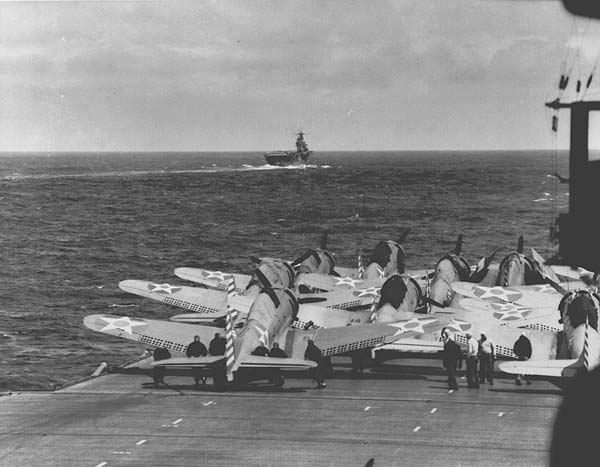
The Hornet as seen from Enterprise
With the two task forces joined as one, they headed straight west. Day after day the came closer and closer to Japan. Watching their compasses and the speed of the ships, they decided that if they didn't change course soon, they would be unloading them in Tokyo Bay. How right they were! The skipper announced that they were to deliver Colonel James Doolittle and the sixteen B-25's to within five hundred miles from Japan itself for a raid on Tokyo. At the word, Gordon cheered along with the thousands of other sailors on the sixteen ships.
Three days from Tokyo, the tankers refueled the carriers and cruisers. The destroyers and the tanker fell behind and the task force plunged deeper and deeper into Jap water until the morning of April 18, 1942. That morning the wind was blowing right out of Tokyo. As the two carriers headed into the wind, and Tokyo, the Enterprise launched her planes first to provide air cover over the task force. Air cover was always a necessity in the war zone. After the combat air patrol was established by the fighters and the dive bombers were on patrol, the Hornet began launching the B-25's, which were never designed for carrier operations.
Gordon watched from the port
forward five inch gun battery as one by one the B-25's lifted off the
Hornet's flight deck. It seemed as though it took forever to get them
all airborne. Every minute brought them closer to Tokyo, and certain
death if they were discovered. As soon as the last bomber left the
deck, the Hornet brought her air group up from the hanger deck and
began launching her planes to add to the air cover. The small task
force turned around and got out of there as fast as they went in. The
term was “Haul out with Halsey.” A couple days later they
rejoined the waiting destroyers on there way back to Pearl Harbor.
The Japanese homeland had been dealt it's first blow of the war. The
damage was slight but the boost to American morale was tremendous.
When the ships returned to Pearl Harbor on the 25th, they were not
permitted to say were they had been as the mission was a well guarded
secret. So much in fact, that when asked where the bombers took off
from, President Roosevelt responded, “From our secret base in
Shangri La.” Shangri-La was a fictional place described in the 1933
novel Lost Horizon.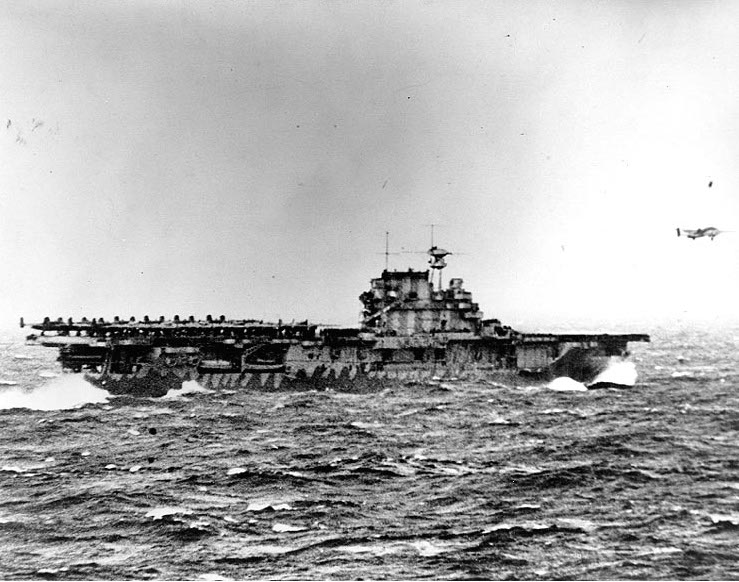
A B-25 taking off from the Hornet
During the first months of the war, Japan had advanced in the Pacific area, rapidly expanding their holdings. The United. States was strictly on the defensive. All there was between the Japanese and the west coast of the United States were a handful of unmercifully outnumbered ships. Japan was increasing their holdings in the Pacific and Asia. With their eye on cutting off the lifeline to Australia, they planed to mount an invasion of Port Moresby on the southern coast of New Guinea. The Yorktown and Lexington were in position to counter the Japanese moves. The Enterprise and Hornet quickly reprovisioned and on the 30th of April departed Pearl Harbor to join the anticipated battle.
As they rushed south,
Gordon crossed equator again om May 5th. Again there was no time to
celebrate. While enroute, news of the Battle of Coral Sea was
received aboard the Enterprise and the other ships of the task force,
which were only a day away from the scene of battle. The Lexington
had been sunk and the Yorktown was severely damaged. The Japanese had
been turned back and were retreating. Coral Sea was the only battle
that the Enterprise missed. The Enterprise and Hornet operated in the
South Pacific until the 16th when they received orders to return to
Pearl Harbor with all haste. After joining up with the Lexington's
former escorts, they set course for Pearl Harbor. The return trip was
Gordon's fourth crossing of the equator.
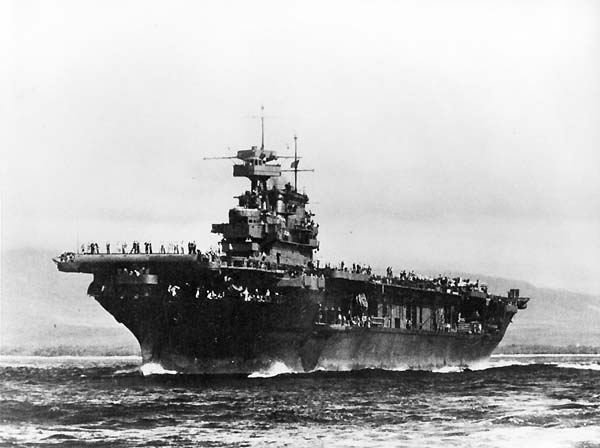
Enterprise in the spring of 1942
The quickly expanding Empire of Japan had plans that would bring the Americans to surrender. In June of 1942 they planned a massive strike at Midway Island, about one thousand miles from Pearl Harbor. There plan was to capture Midway and establish a base. From there, their plan was to destroy the remains of the American fleet and capture the Hawaiian Islands. From Pearl Harbor they would have access to the entire west coast of the United States. The only thing to stop them was the Enterprise, Hornet, and the quickly repaired Yorktown.
After returning to Pearl
Harbor on the 26th of May, the Enterprise and Hornet went to sea
again only two days later on the 28th. The Yorktown was quickly
patched up and she sailed two day after that. And stop them the Japs
they did. On June 4, 1942, four of Japan's finest carriers were sunk
in one day. That morning, the Japs launched their first wave against
Midway. In the mealtime, their carriers were found by U.S. patrol
planes, and an attack was launched immediately from the Enterprise,
Yorktown, and Hornet. Shortly after the strike was launched, the Japs
found the Yorktown and attacked, leaving her seriously damaged,
claiming that it sank.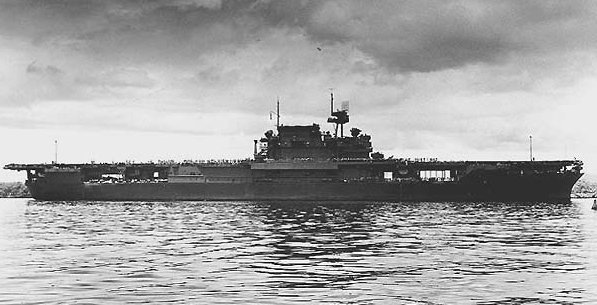
Enterprise entering Pearl Harbor May 26, 1942
The torpedo squadrons were the first to attack the Jap carriers... or rather to be slaughtered. When the dive bombers attacked, the enemy's carrier decks were loaded with armed and fueled planes ready for an attack on the American carriers. They dove out of the sun on three of the unsuspecting carriers, blowing them out of the water.
Planes from the remaining Jap
carrier followed the Yorktown's planes back to the ship. She had put
out her fires and was under way again. Claiming that the Yorktown had
been sunk, they thought they were attacking the Enterprise. Again,
they heavily damaged her and left claiming the Enterprise as sunk.
(They first claimed to have sunk the Enterprise at Pearl Harbor when
they sunk the old Utah. The Enterprise was supposedly to have been
sunk six times earning the title of "The Galloping Ghost.")

The Enterprise at Midway
From one of the five inch guns on the "Big E" Gordon watched the smoke filled horizon as the Yorktown fought for survival. The Jap planes returned from the torture of the Yorktown and prepared for yet another strike. Again, American dive bombers appeared out of nowhere and set the deck load of fueled and armed planes ablaze and the fourth enemy carrier began sinking.
All there was to do for the vast Japanese armada was to do was to withdraw, with the Enterprise and Hornet in pursuit. The Yorktown once again put out the fires and began to repair the damage while being towed back to Pearl Harbor. Unfortunately she was sunk by torpedoes from a Jap sub three days later. The Enterprise and Hornet never were attacked during the battle, however their air groups contributed greatly to the victory. On the 13th of June the victorious Enterprise sailed into Pearl Harbor. The tide of the war had been turned and the Americans would soon be on the offensive.
The picture at the left was
taken of Gordon just after the Battle of Midway. While on liberty in
Honolulu he saw a photography studio and decided to go in and have
his picture taken. When he went back to sea he had forgotten all
about the picture. Nearly a year later while in port again, one of
his shipmates walked past the same studio and saw Gordon's portrait
in the window. Recognizing his buddy, he went in and got the pictures

Gordon - June 1942
and took them back to the ship for Gordon. A copy hung in his
Grandmother Buttars' home until her death in 1952. Another copy hung
in Gordon's home next to a large photograph of the "The Big E” 
was taken many
years after the war.
About this time, while on liberty in Honolulu, Gordon got a tattoo on his right arm. It was a woman wearing a red bathing suit setting above the name of the ship. While on liberty, Gordon lived the fast life, which included drinking and women. He wanted to get as much as he could of both before going back to sea. After all he might not be coming back.
On the 15th of July, the
Enterprise sailed out of Pearl Harbor. Just out of the channel, she
was joined by two cruisers and a brand new battleship as well as the
familiar destroyers of the task force. Once again they set course for
the South Pacific. The thing that was different about this mission
was that this time they were on the offensive. On the 19th, Gordon
crossed the equator for the fifth time. On the 24th of July the
Enterprise dropped anchor at Nufualofa Roads, Tonga for a brief stay.
The harbor was crowded with transports and cargo ships loaded with
men and supplies for the invasion of Guadalcanal. Latter the same
day. The Enterprise and the invasion force departed Tonga and joined
other elements of the fleet on the 26th. After consolidating forces,
Enterprise became part of a larger task force that included the
recently repaired Saratoga and the Wasp which was fresh from the
Atlantic.
20 Millimeter anti-aircraft battery 12 along
the superstructure was Gordon's battle
station during the Battle of the Eastern
Solomons in August 1942
The sleeping Japanese on Guadalcanal were awaken on August 7th by the shore bombardment form the cruisers and destroyers off shore while planes from the Big E, Wasp, and Saratoga provided air cover during the invasion of Guadalcanal. By then Gordon had been transfered from the five inch guns to the 20 millimeters. His new battle station was Battery Twelve, located along the island structure.
After being caught off guard, the Japs launched a counter strike against the American carriers on August 24, 1942. They found the Enterprise. At 5:14 p.m. Three minutes later the first bomb smashed through the aft elevator and exploded five decks below. The big carrier shuddered at the first blow and the crew was thrown off balance. For an instant the guns went silent while the gunners got back on their feet. Thirty seconds later, the second bomb hit only fifteen feet from the first. The five inch gun deck Gordon had just been transfered from three weeks before was demolished, killing forty-three men. Thick black smoke poured from the listing ship with only three-fourths of her guns still firing.
Two minutes after the first
bomb hit, a third bomb blew a ten foot hole in the flight deck
putting the Number Two elevator out of order. By 5:17 the attack was
over but the battle continued as the crew fought the fires and
brought them under control. When the fires were out, the gaping holes
in the flight deck were patched up and an hour and a half after the
first bomb, the air group began coming aboard. Twenty-five planes had
landed before the ship lost steering control. The planes still in the
air landed aboard the Saratoga while the steering was being repaired.
Without steering control, the ship was a sitting duck as another wave
of Jap planes appeared on radar. Fortunately they never found their
target.
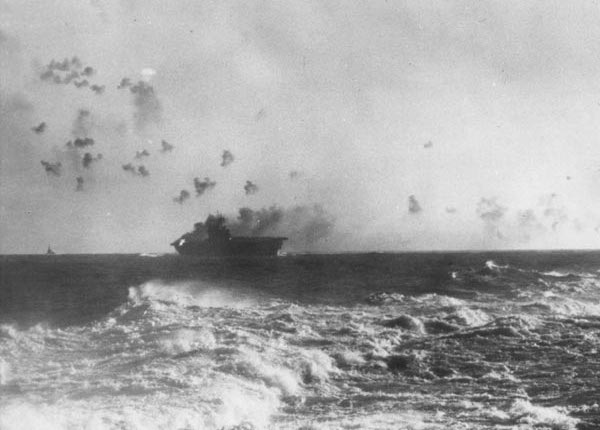
The Enteprise on fire at the Battle of the Eastern Solomons.
When the ship was damaged
like this, the battle goes on long after the last of the enemy planes
leave. The fires have to be brought under control, the wounded tended
to, and the damage patched up good as can be. Then there the debris
to clean up. One time Gordon found a piece of a cog among the debris
that he recognized as part of an International mower. It even had
“International” stamped into it. He kept it for a while and
showed it off. The cod had been packed into the bomb casing to be
hurled as shrapnel when the bomb detonated. He figured it must have
been in some scrap metal that the Japs bought from the United States
before the war.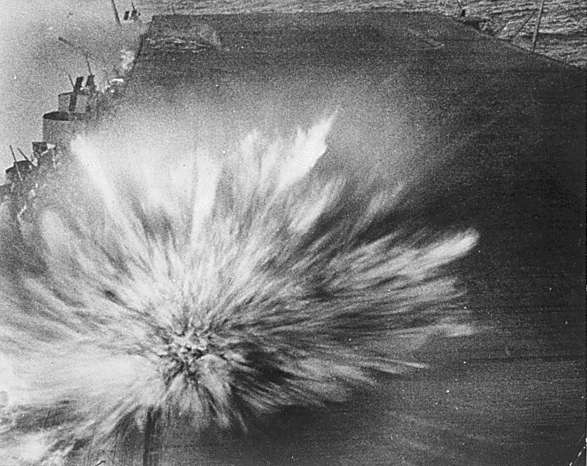
Enterprise hit by the third bomb in two
minutes, Near the aft end of the deck,
smoke can be seen from the first bomb
hit, which obliterated a starboard 5"
gun mount and its crew.
The Enterprise was so badly damaged that she had to go back to Pearl Harbor for repairs. The Enterprise and Saratoga had stopped a major drive to recapture Guadalcanal. The Enterprise was detached from the area and stopped off in Tonga on August 30th and sailed again on September 3rd. She returned to Pearl Harbor on the 10th. The trip back was Gordon's sixth crossing of the equator.
Shortly after the battle, Gordon received the following citation from the Captain:
From: The Commanding Officer
To: Buttars, Gordon G. Sea2c. U.S. Navy
Subject: Commendation
1) The commanding officer takes pleasure in commending you for your
efficient and untiring performance of duty during and after the action
against the enemy off the Solomon Islands on August 24, 1942. As a gunner
and loader on 20 MM Battery No. 12, you preformed your duties in a
particularly cool and efficient manner, thereby contributing materially
to the excellent performance of your battery in shooting down enemy
aircraft. This display of courage and zeal, and your exceptional
performance of duty during this emergency, is considered to be worthy
of special commendation.
2) A copy of this letter will be filed A.C. Davis
with your service record and suitable notation will made there in.

The Enterprise enroute to Pearl Harbor for repairs.